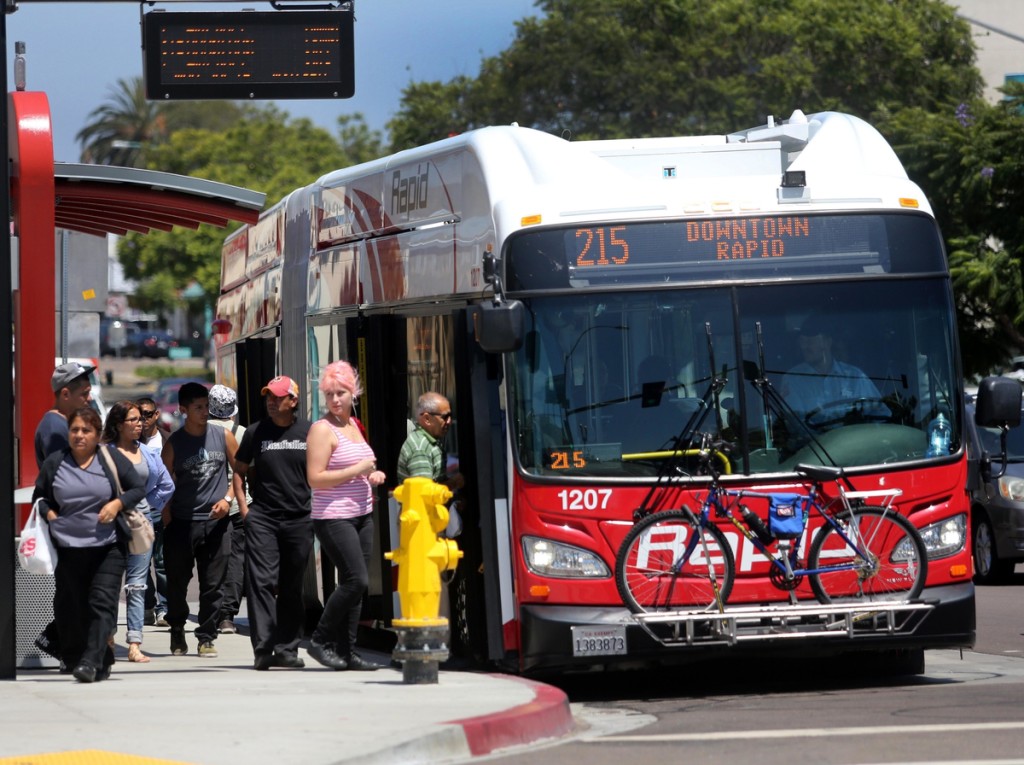
The Mid-City Rapid 215 bus stops at El Cajon Boulevard and 43rd Street. | Photo Credit: Jamie Scott Lytle
El Cajon Boulevard has a ways to go before it becomes the transit corridor planners envision.
Now close to a year old, the Mid-City Rapid 215 hasn’t made taking the bus any easier, keeping the boulevard car-centric and thwarting its future as a dense urban village.
The new transit line isn’t much faster or more dependable than the regular bus it replaced, leaving the boulevard community grasping for the transportation solution it was promised, even while it undergoes a development boom.
The Rapid project, which took a decade to develop, was meant to follow the bus rapid transit, or BRT, model. Initial plans promised a dedicated lane for buses and transit stops with ticketing machines that would speed up the boarding process. Instead, it has a dedicated lane for a short stretch, but shares the road with other cars for most of its route.
“We had envisioned the (Rapid 215) being much more rider-friendly, fast, than it actually is,” said Beryl Forman, marketing director for the Boulevard Improvement Association. “What they proposed in the beginning was not what we got.”
The 215 bus, which travels from SDSU to El Cajon Boulevard and through Balboa Park to downtown, has been on time 83.6 percent of the time on average for the nine months it has been operational, according to MTS figures. That means the rest of the time, buses left their stops at least five minutes later than scheduled.
The 15 bus, which ran on El Cajon Boulevard before the Rapid routes came online, was on time 84 percent of the time in 2013 — about the same as the Rapid 215 buses.
But reliability is a major selling point of BRT lines in the first place.
“It is especially important that BRT service be reliable. … The service standard for schedule adherence is often higher for BRT than for conventional service,” the American Public Transportation Association wrote in its “recommended practice for BRT service design.”
Each of the other four routes in the Metropolitan Transit System’s BRT network are significantly more reliable than Mid-City’s line. The others stay on schedule between 88.8 percent and 96 percent of the time.
Reliability issues are partially due to complications with SANDAG’s traffic signal priority system, meant to allow buses running behind schedule to keep green lights on a little longer. SANDAG says it’s still tweaking the signals along the boulevard, and the Rapid 215 buses’ on-time percentage has increased consistently, albeit slowly, since they began running in October.
Community pushback kept the Rapid 215 from getting its own lane to boost its speed and reliability, including skepticism from the Boulevard Improvement Association itself.
Arnold Torma, a traffic engineer for transportation consultant the KOA Corporation, said El Cajon Boulevard has too many lanes for the cars it carries — meaning it could support a dedicated lane for transit.
He said the boulevard, originally a highway, has the capacity to carry up to 50,000 vehicles per day but now carries only about 19,000 to 21,000 daily, which is why cars can easily get up to 40 mph and above.
“If you were building a street from scratch, and you knew it was going to be carrying 20,000 (vehicles per day), you wouldn’t build six lanes — you’d build four lanes,” Torma said.
The high-speed traffic on El Cajon Boulevard isn’t good news for the Rapid 215. People feel unsafe — the boulevard is one of the eight most dangerous corridors in the city, according to a recent pedestrian safety report — so they’re less likely to feel comfortable walking to and from the transit stops.
Randy Van Vleck, active transportation director for the City Heights Community Development Corporation, said small improvements like curb ramps and crosswalks near Rapid stops would go a long way.
“If we want transit to get more popular, we can’t allow transit access to be a death-defying experience,” Van Vleck said.
The Rapid 215’s early ridership is undershooting initial projections, though not by too much. It’s been averaging 6,508 rides per weekday for the nine months it’s been operational. SANDAG forecast the route would attract 7,000 to 9,000 daily riders by the end of its first year. It could still reach the low end of that estimate by October.
Still, the Rapid has attracted only about 18 percent more riders than the boulevard’s original 15 bus. That’s way below expectations, which suggested the route could improve ridership by 27 to 63 percent.
Dave Gatzke, vice president of acquisitions at affordable housing developer Community HousingWorks, said less-than-effective transit on the boulevard is especially worrisome because of the approaching development boom there.
Even if transit improves down the line, he said, the boulevard’s current car culture is affecting its future by impacting new developments as they’re built.
New buildings still require developers to provide a certain amount of parking, making them more expensive and difficult to build. But if the Rapid 215 were fast and reliable, that wouldn’t be as necessary, Gatzke said.
“When I look up in Seattle and Portland, there isn’t one parking space per resident, and people don’t care, because they have other transit options. Those cities have gotten there,” he said.
“I do wonder if we’re going to end up with a lot of empty parking spaces in these buildings we just designed ten to fifteen years from now.”
Some improvement is on the way: SANDAG is set to spend another $56.3 million — more than the entire initial budget to build the rapid bus line through Mid-City — in federal and county funds to improve two transit stations at El Cajon Boulevard and University. They’ll feature signs telling riders when the next bus comes, elevators and bus shelters. That project is slated to be completed in 2017.
